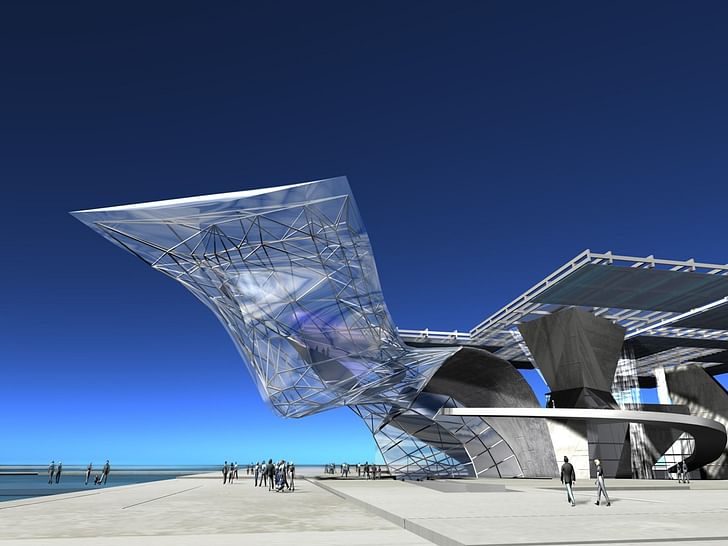

What can one say about the celebrity architect that hasn't already been said, especially if the status itself arguably displaces thoughtful criticism? For former corporate interior designer turned international architectural curator Vladimir Belogolovsky, architectural celebrity is in the eye of the practitioner – and to that end, he has interviewed 30 of architecture's best known professionals about their work, their motivations, and their designs for the future in Conversations with Architects: In the Age of Celebrity.
Celebrity is a weird magnifier. By definition, fame extends a subject's reach beyond the confines of a particular industry of social set into the multiplicity of the public realm, where it can be randomly defined by anyone who encounters it. Architecture, by virtue of extending itself into this heretofore unmapped dimension of fame, must grapple with what that dimension isThink of it this way: for some people, Frank Gehry is a cartoon character who crumples up paper; for others, he's a visionary who transformed the profession with aerospace technology. Belogolovsky quotes others, like critic Kenneth Frampton, going so far as to say Frank Gehry's "not good enough to be an architect."

Famous architects are no longer insulated from the fickle rants of the aesthete on the street, but they are also exponentially empowered when it comes to placing their mark on the world's consciousness. But this reality begs the question: does this celebrity factor influence the actual architecture? Might architecture become so warped by the concerns of fame that discussions of design fundamentals go ignored? Or, in a hyper-mediated age, is fame its own new design concept?

Architects have been famous before the 21st century, of course: to name but one example, Frank Lloyd Wright became something of a household name in the mid-20th century. What’s different this time around is the scope and pervasiveness of fame within the profession. Where fame could be described as a novelty in the architectural world of the 20th century, it is is architecture defined by its desire to be undefinable, the mysterious starlet of the glass and steel realm?now more of a constant force in the 21st. It’s not uncommon for relatively modest firms to hire marketing/PR teams; an architect is expected to have a “presence.” Architecture, by virtue of extending itself into this heretofore unmapped dimension of fame, must grapple with what that dimension is, and Belogolovsky’s book functions as a marvelous (if not inadvertent) catalog of that grappling. No one can agree precisely on what architecture is in the age of celebrity because it is still developing.
Starting on December 18, 2002, when the semifinal plans for the New World Trade Center were unveiled, Vladimir Belogolovsky began conducting interviews with a series of well-known architects about their work. In retrospect, he felt this event marked the beginning of the starchitectural status, because the public was so interested and invested in what would replace the decimated Twin Towers. Architects like Daniel Libeskind, who presented his proposal that day, were no longer simply designers: they were public figures, very publicly shaping the culture.

In the book's foreword, Belogolovsky clearly states that "Most of the architects were interviewed before I had ever heard the term [starchitecture], and such notions as fame and celebrity status are barely mentioned and in just a few of the interviews. It is the work itself, the creative process, and diverse intentions behind it that interest me most." However, he also states that if "contemporary architecture can no longer be defined by a single style or uncompromising school of thought, then perhaps it is the unprecedented status of starchitects and 'starchistructures' that has emerged as our era's unifying theme."

In this spirit, from certified masters Kevin Roche, Robert Stern, and Denise Scott Brown to relatively newer upstarts like Bjarke Ingels and Joshua Prince Ramus, Belogolovsky has compiled a series of interviews that touch on both the specific intent of each architect and their concept of what architecture is in contemporary times. Although globalization is upheld as a defining tenet of architecture by the vast majority of interviewees, even this guideline is subject to redefinition. Norman Foster notes that "the architectural heritage of most countries is a story of globalization before anyone had invented the word...historically, there is a huge amount of cross-fertilization by architects, artists, and artisans who moved around. Globalization has been going on for hundreds of years and today this healthy tradition continues on a different scale."

The book continues in this wry contrarian vein. No two architects agree completely about anything: everything about the profession is defined through the individual prism of the architect being interviewed. Alejandro Aravena, for example, completely disagrees with Wolf Prix's notion that architectural ideas should be shaped by the ability of students to "imagine what is possible" as opposed to a creativity borne of surmounting the obstacles of client demands and program limitations. The definition of space itself within contemporary architecture is in motionWhere Aravena comes across as a somewhat hard-nosed pragmatist, Prix appears to be an untrammeled dreamer. Prix discusses driving trucks in order to earn money to survive while he formulated his approach to architecture, which ultimately resulted in the founding of Coop Himmelb(l)au. Prix notes that "today every young architect wants to get paid, wants to have a client...What we wanted the most was to change architecture. We wanted to change it radically and now!"

This push-pull between practicality and imagination leads to a more subtle, stylistic discussion throughout the book of the breakdown of clearly defined "spaces" in this new era. As Winka Dubbeldam notes, "The Internet brought public space right into our living room, so there is no longer a real separation between private and public." However, this discussion is not limited to the blurring between public and private spaces. Consider the difference between a purposefully conceived narrative in architecture, versus the inadvertent Insert Your Metaphor Here of Elizabeth Diller's Blur Building: the definition of space itself within contemporary architecture is in motion.

So in this era of constant motion, is architecture defined by its desire to be undefinable, the mysterious starlet of the glass and steel realm? Elizabeth Diller, for example, takes pride in the ambiguity of her firm's work. When asked, "Could you try to define the truth that you are in search of?" Diller replies, "I'm not sure there is truth out there. I think questions are beautiful. The answers are dead."
Julia Ingalls is primarily an essayist. Her work has appeared or is forthcoming in Slate, Salon, Dwell, Guernica, The LA Weekly, The Nervous Breakdown, Forth, Trop, and 89.9 KCRW. She's into it.
31 Comments
Can't believe I'm typing this but...that's not Nouvel's Gherkin, have seen his gherkin and that's def. not it.
randomized - you are very much correct. Thanks for pointing out the error, we've corrected this.
Just read this:
http://www.harvarddesignmagazine.org/issues/23/the-work-of-architecture-in-the-age-of-commodification
It's only recently that the celebrities in the field became the worst examples of it--odd when there are so many interesting architects around (or maybe used to be around).
randomized you have seen Nouvels Gherkin? what about Fosters?
I hear Nouvel's gherkin is more pointy.
this post reminded me of this text (1989)
architecture and politics in the reagan era from postmodernism to deconstructivism by Mary McLeod
"Fragmentation, dispersion, decentering, schizophrenia, disturbance are the new objectives; it is from these qualities that architecture is to gain its "critical" edge."
ending of text:
"That contemporary architecture has become so much about surface, image, and play, and that its content has become so ephemeral, so readily transformable and consumable, is partially a product of the neglect of the material dimensions of architecture - program, production, financing, and so forth - that more directly invoke questions of power. And by precluding issues of gender, race, ecology, and poverty, postmodernism and deconstructivism have also forsaken development of a more vital and sustained heterogeneity. The formal and the social costs are too high when the focus is exclusively on form."
-1989-
a lot went down back '89
Architects are like politicians, we start with good intentions and optimistic visions, then we discover that we are working within an inescapable machine, an unbendable framework. Eventually we give in, accept the limits of this system, and create an enormous amount of bullshit to justify and legitimize our inability to affect change, or we simply create the illusion of radical change through superficial re-surfacing and masking.
Interesting how the header image features the smiley celebrity architect hovering... Keep us amused and hope nobody cares about the work itself. The celebrity architects of the peak (1930-70) were world known for their quality work.
@Olaf Design Ninja,
Yes I've seen both their gherkins and have to say I'm much more impressed by Nouvel's, his has a distinct colour pattern that is quite beautiful, the different shades of the cold blue and the fleshy red mix well together imho, haven't seen that on any other gherkin, Foster's is too generic for my taste. I could pick Jean's gherkin out of a line-up easliy.
"I'm not sure there is truth out there. I think questions are beautiful. The answers are dead."
?
Come on, Thayer, can't you recognize inscrutability when you read it? She's just too danged deep for the rest of us.
But, aside from occasional snark, I don't hold celebrities (real ones or architects) as accountable for their sometimes-weird words and behavior as much as I do the (largely) hack media outlets that excerpt --and then lionize or crucify-- those folks for fun and profit.
I really wonder what sort of stick Bjarke Ingels and his buildings are going to have. I'm genuinely interested considering he is the first "celebrity" architect whose celebrity has so much to do with his youth and good looks which of course are two qualities that are extremely fleeting.
I know Donna Sink respects the BIG work. I respect her, so I've tried to look with an open mind but I just don't see it being much more than built gimmickry with a sexy, charming guy with a cute accent selling it.
Also, I continue to wait for the greater world to catch on to what a hack Libeskind is. I think most architects recognize that he is but to my dismay he continues to pull the wool over the eyes of the outside world.
I think this article has helped me to see that now, more than ever, buildings and criticism of buildings are inextricably linked to the characters that design them, possibly to the detriment of architecture. It's never about "What is this building trying to do?" It's about "What was the architect trying to do?" The building can't be examined in its own light, its's always an extension of the the architect. So if, like the gentleman above, you happen to not like the architect, it is impossible to give an objective critique of the architecture. But can architecture be famous in its own right, or does it absolutely need a charismatic spokesperson to generate public interest?
I like what the author said about this era in architecture being defined by its reluctance to be defined. I also like the Diller quote at the end. I'm not sure exactly what she is trying to say, but I agree lol.
DTElmore,
I think you make a good point about the centrality of the architect. It's like an artist where the building is an expression of their personal journey when it should actually be about the place and the users that will interact with the building. I don't know how one reverses this narrative, but pulling architecture away from being a vehicle for personal expression towards it's users would be a start. Problem there is our education tends to belittle the end user.
DTElmore, to be clear, I didn't write that I don't like Bjarke Ingels as a person. He is clearly smart, charming, gorgeous, and successful and I would have sex with him in a heartbeat. However try as I might I just can't see the quality in his work that other people, such as Donna Sink see in it.
I definitely don't like Libeskind's work and that is based purely on his work and not at all on the person.
^ "...smart, charming, gorgeous, and successful and I would have sex... in a heartbeat."
I've said the exact same thing about Zaha.
When I graduated - I aspired to be like Bjarke - then reality set in - perhaps in some future lifetime then
Bjarke has this rare quality known as faith in self - when he was at OMA, he was fearless at presenting his ideas and within that environment metamorphisized into he is - same with Joshua Prince-Ramus - both OMA alumnus had an enormous amount of faith and follow through -
Xenakis, you just summed up perfectly the privilege that comes with being a good looking monied white boy that everyone wants to fuck.
but does he have a gherkin like Nouvel and Foster and has randomized seen it.
Bjarke's gherkin is a little rough around the edges, like an 8bit version of a gherkin, nothing smooth and sensual there.
What are you talking about quindam? There isn't any contradiction between my posts.
By reducing the architectural process to a 3D sequential diagramming process, BIG was/is able to leverage a lot of information(information driven architecture) to reach a solution quicker than legacy type processes if you will. - Just like video game design
i want to take baseball bats to millinials who think our profession is as easy as Bjarke explains it.....and i am only 10 years older
or same age, slightly younger, than Bjarke. Bjarke is the dream and none of these kids understand what is actually involved. now give the man a Gherkin project
jan kaplicky gherkin
calatrava gherkin
"By reducing the result of the architectural design process to a 3D sequential diagramming presentation..."
by making life so simple everyone can do anything, everyoneone is capable of anything, let alone understanding it.
let's keep diving into the media hype, let's loose ourselves to eye candy, let's lose ourselves to oblivion of illusions. let's not really care that we are nowhere close to the hard working people our grandparents were.
don't you tear up when you think of your grandma and grandpa. those fuckers worked. they self respected themselves by taking on the challenges and delivering and then some. they never complained, they never bitched - THEY DELIVERED.
you millinial retards respect yourselves on conditional facebook and tweets. a fart in the wind makes you find meaning.
WHAT HAPPENED TO TIME?!?!
WHAT HAPPENED TO BECOMING?!?!
WHAT HAPPENED TO LEARNING ABOUT YOURSELF AND FIGHTING THE WORLD FOR IT?
don't you kids realize that is who Bjarke is. He's not a formula, he did it and is doing it anti-grain.
you can't be anti-grain if you don't know the grain.
don't make me catch you in a dark alley, I will beat most of you silly with a baseball bat.
sometimes you have to live to be alive - kids
/\ Robert AM Stern 2 from left
Block this user
Are you sure you want to block this user and hide all related comments throughout the site?
Archinect
This is your first comment on Archinect. Your comment will be visible once approved.